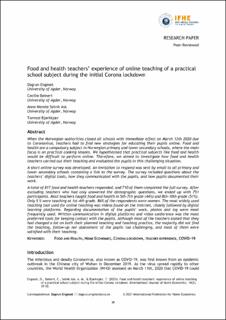| dc.contributor.author | Engeset, Dagrun | |
| dc.contributor.author | Beinert, Cecilie | |
| dc.contributor.author | Ask, Anne Merete Selvik | |
| dc.contributor.author | Bjørkkjær, Tormod | |
| dc.date.accessioned | 2023-10-10T12:06:11Z | |
| dc.date.available | 2023-10-10T12:06:11Z | |
| dc.date.created | 2021-08-18T10:06:58Z | |
| dc.date.issued | 2021 | |
| dc.identifier.citation | Engeset, D., Beinert, C., Ask, A. M. S. & Bjørkkjær, T. (2021). Food and health teachers’ experience of online teaching of a practical school subject during the initial Corona lockdown. International Journal of Home Economics, 14(2), 39-52. | en_US |
| dc.identifier.issn | 1999-561X | |
| dc.identifier.uri | https://hdl.handle.net/11250/3095500 | |
| dc.description.abstract | When the Norwegian authorities closed all schools with immediate effect on March 12th 2020 due to Coronavirus, teachers had to find new strategies for educating their pupils online. Food and health are a compulsory subject in Norwegian primary and lower secondary schools, where the main focus is on practical cooking lessons. We hypothesised that practical subjects like food and health would be difficult to perform online. Therefore, we aimed to investigate how food and health teachers carried out their teaching and evaluated the pupils in this challenging situation. A short online survey was developed. An invitation to respond was sent by email to all primary and lower secondary schools containing a link to the survey. The survey included questions about the teachers’ digital tools, how they communicated with the pupils, and how pupils documented their work. A total of 817 food and health teachers responded, and 710 of them completed the full survey. After excluding teachers who had only answered the demographic questions, we ended up with 751 participants. Most teachers taught food and health in 5th-7th grade (44%) and 8th-10th grade (51%). Only 5 % were teaching at 1st-4th grade. 86% of the respondents were women. The most widely used teaching tool used for online teaching was videos found on the internet, closely followed by digital learning platforms. Regarding documentation of the pupils’ work, photos and log were most frequently used. Written communication in digital platforms and video conference was the most preferred tools for keeping contact with the pupils. Although most of the teachers stated that they had changed a lot on both their planned teaching and teaching practice, the majority did not find the teaching, follow-up nor assessment of the pupils too challenging, and most of them were satisfied with their teaching. | en_US |
| dc.language.iso | eng | en_US |
| dc.publisher | International Federation for Home Economics | en_US |
| dc.rights | Attribution-NonCommercial-NoDerivatives 4.0 Internasjonal | * |
| dc.rights.uri | http://creativecommons.org/licenses/by-nc-nd/4.0/deed.no | * |
| dc.title | Food and health teachers’ experience of online teaching of a practical school subject during the initial Corona lockdown | en_US |
| dc.type | Peer reviewed | en_US |
| dc.type | Journal article | en_US |
| dc.description.version | publishedVersion | en_US |
| dc.rights.holder | © 2021 International Federation for Home Economic | en_US |
| dc.subject.nsi | VDP::Medisinske Fag: 700::Helsefag: 800::Ernæring: 811 | en_US |
| dc.source.pagenumber | 39-52 | en_US |
| dc.source.volume | 14 | en_US |
| dc.source.journal | International Journal of Home Economics | en_US |
| dc.source.issue | 1 | en_US |
| dc.identifier.doi | https://www.ifhe.org/fileadmin/user_upload/e_Journal/IJHE_Volume_14_Issue1_2021.pdf | |
| dc.identifier.cristin | 1926865 | |
| dc.relation.project | Universitetet i Agder: 689019 | en_US |
| dc.description.localcode | Paid open access | en_US |
| cristin.qualitycode | 1 | |

